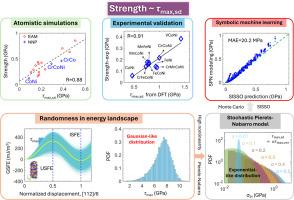当前位置:
X-MOL 学术
›
Acta Mater.
›
论文详情
Our official English website, www.x-mol.net, welcomes your
feedback! (Note: you will need to create a separate account there.)
Standard deviation in maximum restoring force controls the intrinsic strength of face-centered cubic multi-principal element alloys
Acta Materialia ( IF 8.3 ) Pub Date : 2024-11-02 , DOI: 10.1016/j.actamat.2024.120508 Fei Shuang, Luca Laurenti, Poulumi Dey
Acta Materialia ( IF 8.3 ) Pub Date : 2024-11-02 , DOI: 10.1016/j.actamat.2024.120508 Fei Shuang, Luca Laurenti, Poulumi Dey

|
In this study, we explore the mechanisms underlying the exceptional intrinsic strength of face-centered cubic (FCC) Multi-Principal Element Alloys (MPEAs) using a multifaceted approach. Our methods integrate atomistic simulations, informed by both embedded-atom model and neural network potentials, with first-principles calculations, stochastic Peierls-Nabarro (PN) modeling, and symbolic machine learning. We identify a consistent, robust linear correlation between the strength of MPEAs and the standard deviation of the maximum stacking-fault restoring force (τ max,sd ) across various potentials. This finding is substantiated by comparing the experimental strengths of Cantor alloys’ subsystems and Ni62.5 V37.5 against τ max,sd values from high-throughput first-principle calculations. Our theoretical insights are derived from integrating the stochastic Peierls-Nabarro model with a shearable precipitation hardening framework, demonstrating that lattice distortion alone does not directly enhance intrinsic strength. Instead, τ max,sd emerges as a critical determinant, capable of boosting the strength of MPEAs by up to tenfold. Our analysis reveals the critical role of the exponential form of the PN model in achieving substantial strength improvement by transforming the Gaussian-like distribution of τ max into an exponential-like distribution of local Peierls stress. Additionally, using an advanced symbolic machine learning technique, the sure independence screening and sparsifying operator (SISSO) method, we derive interpretable relationships between MPEA strength, elastic properties, and τ max statistics, offering new insights into the design and optimization of advanced MPEAs. These findings highlight that the nonlinear physics and atomic fluctuations characterizing MPEAs not only underpin their unconventional intrinsic strength but also contribute to other complex properties such as sluggish diffusion and cocktail effect.
中文翻译:

最大恢复力的标准差控制面心立方多主元素合金的内在强度
在这项研究中,我们使用多方面方法探讨了面心立方 (FCC) 多主元素合金 (MPEA) 非凡内在强度背后的机制。我们的方法将原子模拟与第一性原理计算、随机 Peierls-Nabarro (PN) 建模和符号机器学习相结合,以嵌入原子模型和神经网络势为依据。我们确定了 MPEA 的强度与各种电位下的最大堆叠故障恢复力 (τmax,sd) 的标准差之间一致、稳健的线性相关性。通过将 Cantor 合金子系统和 Ni62.5V37.5 的实验强度与高通量第一性原理计算的 τmax,sd 值进行比较,证实了这一发现。我们的理论见解是通过将随机 Peierls-Nabarro 模型与可剪切沉淀硬化框架相结合而得出的,证明晶格变形本身并不能直接增强内禀强度。相反,τmax,sd 成为一个关键决定因素,能够将 MPEA 的强度提高多达 10 倍。我们的分析揭示了 PN 模型的指数形式通过将 τmax 的高斯样分布转换为局部 Peierls 应力的指数样分布,在实现实质性强度提高方面的关键作用。此外,使用先进的符号机器学习技术,即确定独立性筛选和稀疏运算符 (SISSO) 方法,我们得出了 MPEA 强度、弹性特性和 τmax 统计数据之间的可解释关系,为高级 MPEA 的设计和优化提供了新的见解。 这些发现强调,MPEA 的非线性物理学和原子涨落不仅支撑了其非常规的内在强度,而且还促成了其他复杂特性,例如缓慢扩散和鸡尾酒效应。
更新日期:2024-11-02
中文翻译:

最大恢复力的标准差控制面心立方多主元素合金的内在强度
在这项研究中,我们使用多方面方法探讨了面心立方 (FCC) 多主元素合金 (MPEA) 非凡内在强度背后的机制。我们的方法将原子模拟与第一性原理计算、随机 Peierls-Nabarro (PN) 建模和符号机器学习相结合,以嵌入原子模型和神经网络势为依据。我们确定了 MPEA 的强度与各种电位下的最大堆叠故障恢复力 (τmax,sd) 的标准差之间一致、稳健的线性相关性。通过将 Cantor 合金子系统和 Ni62.5V37.5 的实验强度与高通量第一性原理计算的 τmax,sd 值进行比较,证实了这一发现。我们的理论见解是通过将随机 Peierls-Nabarro 模型与可剪切沉淀硬化框架相结合而得出的,证明晶格变形本身并不能直接增强内禀强度。相反,τmax,sd 成为一个关键决定因素,能够将 MPEA 的强度提高多达 10 倍。我们的分析揭示了 PN 模型的指数形式通过将 τmax 的高斯样分布转换为局部 Peierls 应力的指数样分布,在实现实质性强度提高方面的关键作用。此外,使用先进的符号机器学习技术,即确定独立性筛选和稀疏运算符 (SISSO) 方法,我们得出了 MPEA 强度、弹性特性和 τmax 统计数据之间的可解释关系,为高级 MPEA 的设计和优化提供了新的见解。 这些发现强调,MPEA 的非线性物理学和原子涨落不仅支撑了其非常规的内在强度,而且还促成了其他复杂特性,例如缓慢扩散和鸡尾酒效应。


















































 京公网安备 11010802027423号
京公网安备 11010802027423号